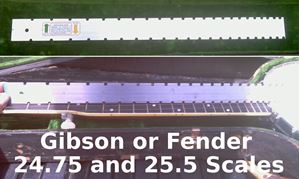StewMac sells a fret press that works for all of the frets that you can slide into the press- not an issue with a bolt-on neck but I wondered if there is a way to use the caul and inserts to press in the frets that cannot be accessed by the StewMac fret press ($110.89).

STEWMAC.COM - Fret Arbor Press only, with table
And then the answer came to me like a bolt of lightning from the skies: mount the caul in a Harbor Freight handscrew clamp:

12 in. Handscrew Clamp
I have been using such a clamp to hold down wooden radiused blocks as a gluing caul for the upper frets (I put a strip of neoprene on the bottom jaw to keep it from damaging the back of the guitar.)
So how to attach the fret press caul? The answer struck me like a 7/8" bolt thrown at me by someone who wanted me to "just shut the fuck up with these tired old cliches" to quote his exact words... Drill a hole in the top jaw of the wooden clamp and insert a piece of tubing or pipe with an ID of ~.375" (or 9.5mm).
Okay- so how to keep the caul in the wooden clamp? (No more bolts, thank you!) Before gluing in the pipe place a neo magnet in the bottom of the hole. (I checked and the caul shaft is ferrous.) Hopefully I can find a magnet which can be held in place by the pipe or tubing. (If not I could drill a larger hole on the opposite side of the wooden jaw.)
One caveat: I'm sure that the wooden clamp will not exert as much pressure as the fret press but the other (low cost) option is to just hammer the fret in. I'll see how the wooden clamp works when I put together the jig.
Bonus idea: you could use a smaller wooden handclamp to use the fret press caul and inserts on the accessible frets. If you already have the StewMac neck caul you are in business. Otherwise you could shape the bottom jaw to fit the neck back and line it with cork.
Here is what the fret press caul ($52.42) and neck support caul ($11.27) look like:

STEWMAC.COM - Fret Press Caul with 5 Fret Press Inserts

STEWMAC.COM - Neck Support Caul
Steve Ahola
P.S. If you don't already have the fret press caul and neck support caul it is cheaper to buy the fret press system ($169.12) which is out of stock at this time.

STEWMAC.COM - Fret Arbor Press System
The brass inserts included with the fret press caul are (6", 7-1/4", 9-1/2", 12" and 16") so you might want to order additional sizes for $4.45 each...
STEWMAC.COM - Fret Press Inserts
P.P.S Since I already had the fret press caul and neck support caul I decided to pull the trigger on the $110 fret press. This was after looking at arbor presses at Harbor Freight and deciding that there was too much work to be done to make them half-way as good as the StewMac press.

STEWMAC.COM - Fret Arbor Press only, with table
And then the answer came to me like a bolt of lightning from the skies: mount the caul in a Harbor Freight handscrew clamp:
12 in. Handscrew Clamp
I have been using such a clamp to hold down wooden radiused blocks as a gluing caul for the upper frets (I put a strip of neoprene on the bottom jaw to keep it from damaging the back of the guitar.)
So how to attach the fret press caul? The answer struck me like a 7/8" bolt thrown at me by someone who wanted me to "just shut the fuck up with these tired old cliches" to quote his exact words... Drill a hole in the top jaw of the wooden clamp and insert a piece of tubing or pipe with an ID of ~.375" (or 9.5mm).
Okay- so how to keep the caul in the wooden clamp? (No more bolts, thank you!) Before gluing in the pipe place a neo magnet in the bottom of the hole. (I checked and the caul shaft is ferrous.) Hopefully I can find a magnet which can be held in place by the pipe or tubing. (If not I could drill a larger hole on the opposite side of the wooden jaw.)
One caveat: I'm sure that the wooden clamp will not exert as much pressure as the fret press but the other (low cost) option is to just hammer the fret in. I'll see how the wooden clamp works when I put together the jig.
Bonus idea: you could use a smaller wooden handclamp to use the fret press caul and inserts on the accessible frets. If you already have the StewMac neck caul you are in business. Otherwise you could shape the bottom jaw to fit the neck back and line it with cork.
Here is what the fret press caul ($52.42) and neck support caul ($11.27) look like:
STEWMAC.COM - Fret Press Caul with 5 Fret Press Inserts
STEWMAC.COM - Neck Support Caul
Steve Ahola
P.S. If you don't already have the fret press caul and neck support caul it is cheaper to buy the fret press system ($169.12) which is out of stock at this time.
STEWMAC.COM - Fret Arbor Press System
The brass inserts included with the fret press caul are (6", 7-1/4", 9-1/2", 12" and 16") so you might want to order additional sizes for $4.45 each...
STEWMAC.COM - Fret Press Inserts
P.P.S Since I already had the fret press caul and neck support caul I decided to pull the trigger on the $110 fret press. This was after looking at arbor presses at Harbor Freight and deciding that there was too much work to be done to make them half-way as good as the StewMac press.






Comment